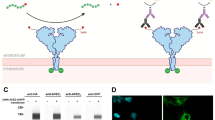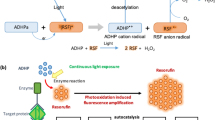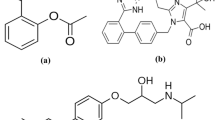Abstract
The determination of angiotensin-converting enzyme (ACE) activity represents a useful tool in the study of different health pathologies, such as hypertension. This protocol describes a fluorescent assay for measuring ACE activity in vitro with high precision and sensitivity. The method relies on the ability of ACE to hydrolyse the internally quenched fluorescent substrate o-aminobenzoylglycyl-p-nitro-L-phenylalanyl-L-proline. The generation of the fluorescent product o-aminobenzoylglycine can be continuously monitored, preferably using a microtiter-plate fluorometer, though the use of a conventional cuvette fluorometer would also be possible. The method has important advantages with respect to other assays, because it involves only a one-step reagent, is easy to carry out and allows the analysis of an elevated number of samples in shorter times. It can be completed in one and a half hours. In addition, the fact that all reagents are commercially available allows the rapid introduction of the assay into the laboratory.
This is a preview of subscription content, access via your institution
Access options
Subscribe to this journal
Receive 12 print issues and online access
$259.00 per year
only $21.58 per issue
Buy this article
- Purchase on Springer Link
- Instant access to full article PDF
Prices may be subject to local taxes which are calculated during checkout

Similar content being viewed by others
References
Corvol, P., Eyries, M. & Soubrier, F. Handbook of Proteolytic Enzymes (eds. Barrett, A.J., Rawlings, N.D. & Woessner, J.F.) 332–346 (Elsevier Academic Press, London, 2004).
Houston, M.C. The role of vascular biology, nutrition and nutraceuticals in the prevention and treatment of hypertension. JANA S 1, 1–71 (2002).
Ruprecht, B. et al. Corrected normal values for serum ACE by genotyping the deletion-/insertion-polymorphism of the ACE gene. Pneumologie 55, 326–332 (2001).
Shibahara, H. et al. Activity of testis angiotensin converting enzyme (ACE) in ejaculated human spermatozoa. Int. J. Androl. 24, 295–299 (2001).
Savary, K. et al. Role of the renin-angiotensin system in primitive erythropoiesis in the chick embryo. Blood 105, 103–110 (2005).
Kowa, H. et al. Association of the insertion/deletion polymorphism of the angiotensin I-converting enzyme gene in patients of migraine with aura. Neurosci. Lett. 374, 129–131 (2005).
Cushman, D.W. & Cheung, H.S. Spectrophotometric assay and properties of the angiotensin-converting enzyme of rabbit lung. Biochem. Pharmacol. 20, 1637–1648 (1971).
Arihara, K., Nakashima, Y., Mukai, T., Ishikawa, S. & Itoh, M. Peptide inhibitors for angiotensin I-converting enzyme from enzymatic hydrolysates of porcine skeletal muscle proteins. Meat Sci. 57, 319–324 (2001).
Hernandez-Ledesma, B., Martin-Alvarez, P.J. & Pueyo, E. Assessment of the spectrophotometric method for determination of angiotensin-converting-enzyme activity: influence of the inhibition type. J. Agric. Food Chem. 51, 4175–4179 (2003).
Kim, S., Kim, S. & Song, K.B. Purification of an ACE inhibitory peptide from hydrolysates of duck meat protein. Nutr. Food 8, 66–69 (2003).
Sentandreu, M.A. & Toldrá, F. A rapid, simple and sensitive fluorescence method for the assay of angiotensin-I converting enzyme. Food Chem. 97, 546–554 (2006).
Carmel, A. & Yaron, A. An intramolecularly quenched fluorescent tripeptide as a fluorogenic substrate of angiotensin-I-converting enzyme and of bacterial dipeptidyl carboxypeptidase. Eur. J. Biochem. 87, 265–273 (1978).
Oliveira, E.M., Santos, R.A. & Krieger, J.E. Standardization of a fluorimetric assay for the determination of tissue angiotensin-converting enzyme activity in rats. Braz. J. Med. Biol. Res. 33, 755–764 (2000).
Cheviron, N. et al. Coumarin-Ser-Asp-Lys-Pro-OH, a fluorescent substrate for determination of angiotensin-converting enzyme activity via high-performance liquid chromatography. Anal. Biochem. 280, 58–64 (2000).
Elbl, G. & Wagner, H. A new method for the in vitro screening of inhibitors of angiotensin-converting enzyme (Ace), using the chromophore-labeled and fluorophore-labeled substrate, dansyltriglycine. Planta Med. 57, 137–141 (1991).
Cheung, H.S., Wang, F.L., Ondetti, M.A., Sabo, E.F. & Cushman, D.W. Binding of peptide substrates and inhibitors of angiotensin-converting enzyme. Importance of the COOH-terminal dipeptide sequence. J. Biol. Chem. 255, 401–407 (1980).
Ono, S., Hosokawa, M., Miyashita, K. & Takahashi, K. Inhibition properties of dipeptides from salmon muscle hydrolysate on angiotensin I-converting enzyme. Int. J. Food Sci. Technol. 41, 383–386 (2006).
Suetsuna, K., Maekawa, K. & Chen, J.R. Antihypertensive effects of Undaria pinnatifida (wakame) peptide on blood pressure in spontaneously hypertensive rats. J. Nutr. Biochem. 15, 267–272 (2004).
Yamamoto, N., Ejiri, M. & Mizuno, S. Biogenic peptides and their potential use. Curr. Pharm. Des. 9, 1345–1355 (2003).
Fuglsang, A., Nilsson, D. & Nyborg, N.C. Characterization of new milk-derived inhibitors of angiotensin converting enzyme in vitro and in vivo. J. Enzyme Inhib. Med. Chem. 18, 407–412 (2003).
Murray, B.A., Walsh, D.J. & FitzGerald, R.J. Modification of the furanacryloyl-L-phenylalanylglycylglycine assay for determination of angiotensin-I-converting enzyme inhibitory activity. J. Biochem. Bioph. Meth. 59, 127–137 (2004).
Sentandreu, M.A. & Toldrá, F. Oligopeptides hydrolysed by muscle dipeptidyl peptidases can generate angiotensin-I converting enzyme inhibitory dipeptides. Eur. Food Res. Technol. (in the press).
Sentandreu, M.A. & Toldrá, F. Evaluation of ACE inhibitory activity of dipeptides generated by the action of porcine muscle dipeptidyl peptidases. Food Chem. 101, 1629–1633 (2007).
Acknowledgements
This work was supported by an I3P contract from the European Social Fund (M.A.S.) and by a Marie Curie ERG grant from the European Commission (M.A.S.).
Author information
Authors and Affiliations
Corresponding authors
Ethics declarations
Competing interests
The authors declare no competing financial interests.
Rights and permissions
About this article
Cite this article
Ángel Sentandreu, M., Toldrá, F. A fluorescence-based protocol for quantifying angiotensin-converting enzyme activity. Nat Protoc 1, 2423–2427 (2006). https://doi.org/10.1038/nprot.2006.349
Published:
Issue Date:
DOI: https://doi.org/10.1038/nprot.2006.349
This article is cited by
-
Comparing the Effectiveness of Three Different Biorefinery Processes at Recovering Bioactive Products from Hemp (Cannabis sativa L.) Byproduct
Food and Bioprocess Technology (2020)
-
Rapid screening and identification of ACE inhibitors in snake venoms using at-line nanofractionation LC-MS
Analytical and Bioanalytical Chemistry (2017)
-
Phytochemical profile and angiotensin I converting enzyme (ACE) inhibitory activity of Limonium michelsonii Lincz
Journal of Natural Medicines (2017)
-
Egg white hydrolysates with in vitro biological multiactivities to control complications associated with the metabolic syndrome
European Food Research and Technology (2016)
-
A Multistrategic Approach in the Development of Sourdough Bread Targeted Towards Blood Pressure Reduction
Plant Foods for Human Nutrition (2015)
Comments
By submitting a comment you agree to abide by our Terms and Community Guidelines. If you find something abusive or that does not comply with our terms or guidelines please flag it as inappropriate.



